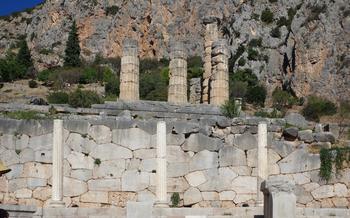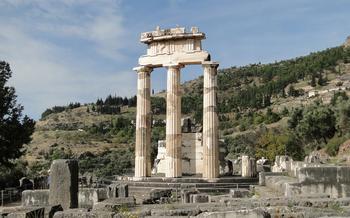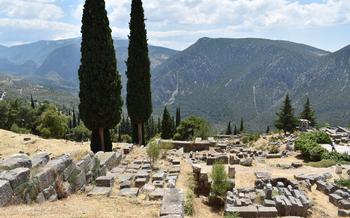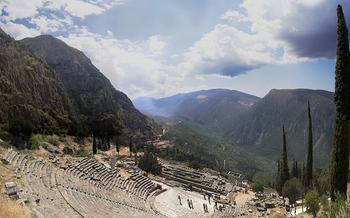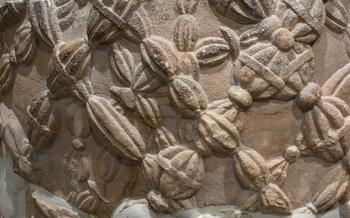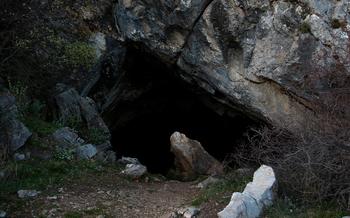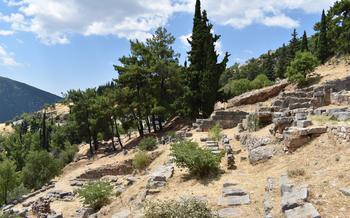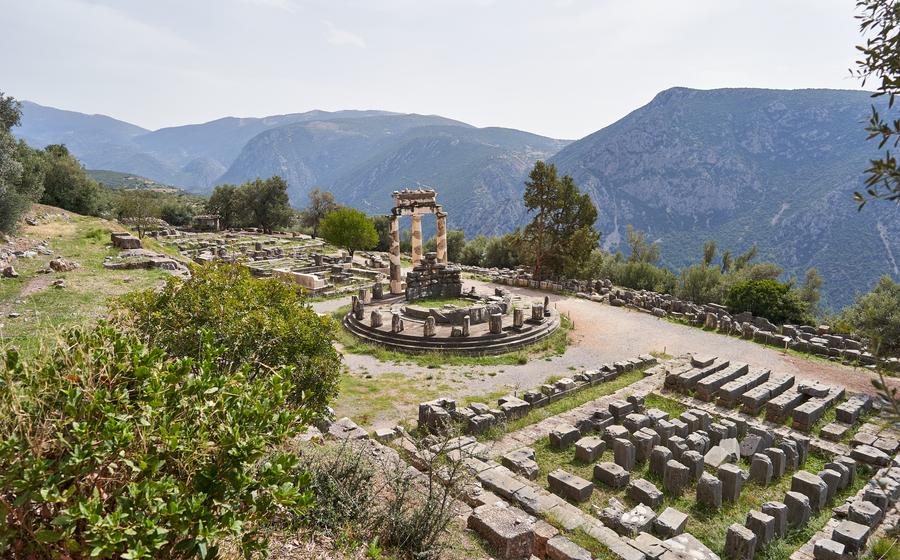
Sanctuary of Athena Pronaia
- Historical Significance: A Sacred Site of Ancient Greece
- Location and Access
- Architectural Masterpieces
- Religious Practices: Unveiling the Sacred Rituals and Prophecies
- Offerings and Dedications
- Natural Surroundings
- Hiking and Exploration
- Festivals and Events
- Photography Opportunities
- Local Cuisine and Dining
- Accommodation and Lodging
- Tour Guides and Guided Tours
- Accessibility and Facilities
- Insider Tip: Unveiling the Secret Path and Sunrise Serenity
Historical Significance: A Sacred Site of Ancient Greece
Delphi, an ancient city nestled amidst the slopes of Mount Parnassus, holds a profound historical significance as a major religious center in ancient Greece. The Sanctuary of Athena Pronaia, located just outside the city walls, served as a sacred ground dedicated to the goddess Athena, who was revered as the protector of Delphi. This sanctuary, with its rich history and religious significance, played a pivotal role in the spiritual and cultural life of ancient Greeks. Its inclusion in UNESCO's World Heritage list further underscores its exceptional value and enduring legacy.
Location and Access
To reach Delphi and the Sanctuary of Athena Pronaia, visitors can take a scenic drive from Athens, which takes approximately 2 hours and 30 minutes. The sanctuary is located just outside the modern town of Delphi, making it easily accessible on foot or by car. If you're traveling by public transportation, regular buses connect Athens to Delphi, with a journey time of about 3 hours.
Once in Delphi, follow the signs to the archaeological site. The sanctuary is situated at the foot of Mount Parnassus, a short walk from the town center. The proximity to other attractions in the region, such as the Delphi Archaeological Museum and the picturesque village of Arachova, makes Delphi an ideal base for exploring this beautiful part of Greece. Refer to the provided map or use GPS navigation for easy orientation.
Architectural Masterpieces
The Sanctuary of Athena Pronaia is home to several remarkable architectural masterpieces that showcase the skill and artistry of ancient Greek builders. The most prominent structure is the Tholos of Athena Pronaia, a circular temple with a colonnade of 20 Doric columns. Its unique design and well-preserved condition make it a standout feature of the sanctuary.
The Temple of Athena Pronaia, also known as the Older Temple, is another notable structure. Built in the 6th century BC, it features a Doric order and is adorned with intricate sculptures depicting scenes from Greek mythology. The temple's pediments, which depict the battle between the gods and the giants, are particularly impressive.
In addition to these two main temples, the sanctuary also includes other notable structures such as the Treasury of the Athenians, a small temple dedicated to Athena that was built to commemorate the Athenian victory over the Persians at the Battle of Marathon. The Treasury features a Doric frieze depicting scenes from the battle.
The architectural masterpieces of the Sanctuary of Athena Pronaia are a testament to the skill and artistry of ancient Greek builders. They are a must-see for anyone interested in ancient history, architecture, or archaeology.
Religious Practices: Unveiling the Sacred Rituals and Prophecies
Oracles and Prophecies: The Sanctuary of Athena Pronaia was renowned throughout the ancient world for its prophetic powers. Visitors sought guidance and wisdom from the oracle of Delphi, who was believed to channel the voice of the god Apollo. The oracle's pronouncements, often delivered in cryptic verses, influenced major decisions in politics, warfare, and personal lives.
Priests and Priestesses: The religious rituals at the sanctuary were conducted by priests and priestesses who were highly respected and held positions of great authority. The priests, known as "Hierosynai," were responsible for maintaining the sanctuary, performing sacrifices and libations, and interpreting the oracle's prophecies. The priestesses, or "Pythia," were chosen for their purity and spiritual connection and were believed to be the mouthpiece of the oracle.
Unique Rituals and Practices: In addition to the consultations with the oracle, the sanctuary hosted various religious festivals and ceremonies. The most notable was the Pythian Games, held every four years in honor of Apollo. These games included athletic competitions, musical performances, and theatrical productions, drawing participants and spectators from across the Greek world.
The sanctuary also witnessed unique rituals, such as the symbolic marriage between the god Zeus and the goddess Hera, which was celebrated with a grand procession and a sacred feast. These rituals reflected the deep religious beliefs and practices of ancient Greece, showcasing the significance of the Sanctuary of Athena Pronaia as a spiritual center in the ancient world.
Offerings and Dedications
As visitors sought the favor of Athena Pronaia, they left behind a rich array of offerings, expressing their devotion and gratitude. These offerings varied in form and value, embodying the hopes and aspirations of those who sought divine guidance.
Among the most common offerings were votive tablets, inscribed with prayers, thanksgivings, or dedications to the goddess. These tablets, often made of bronze or lead, were placed within the sanctuary, serving as permanent records of the supplicant's devotion.
Statues and figurines were another common form of offering, representing the deity herself or other mythological figures. These exquisite works of art, crafted from marble, bronze, or terracotta, adorned the sanctuary, adding to its grandeur and beauty.
Inscriptions, carved on stone or metal, recorded the names of individuals, families, or entire cities who had made significant contributions to the sanctuary. These inscriptions served as a testament to the widespread reverence for Athena Pronaia and the sanctuary's importance as a religious center.
Among the most notable offerings found at the sanctuary is a series of gold and ivory plaques depicting scenes from Greek mythology. These exquisite works of art, dating back to the 6th century BCE, offer a glimpse into the religious beliefs and artistic traditions of ancient Greece.
Natural Surroundings
The Sanctuary of Athena Pronaia is nestled amidst a breathtaking natural setting that played an integral role in ancient Greek religion and mythology. The sanctuary is situated on the slopes of Mount Parnassus, a sacred mountain revered by the ancient Greeks as the home of the Muses, the goddesses of the arts and inspiration. The sanctuary is also home to the Castalian Spring, a natural spring believed to have prophetic powers. According to legend, drinking from the spring's waters could grant poetic inspiration and the ability to see the future. The spring was considered so sacred that it was used for ritual purification ceremonies before entering the sanctuary.
The natural surroundings of the Sanctuary of Athena Pronaia were not just a backdrop but an integral part of the religious experience. The ancient Greeks believed that the natural world was imbued with divine power, and the sanctuary's setting reflected this belief. The towering Mount Parnassus, with its rugged cliffs and lush forests, was seen as a symbol of the gods' power and majesty. The Castalian Spring, with its crystal-clear waters and supposed prophetic powers, was considered a sacred source of inspiration and knowledge. Visitors to the sanctuary would often drink from the spring or bathe in its waters as part of their religious rituals.
The natural beauty of the sanctuary's surroundings also played a role in the religious festivals and ceremonies held there. The annual Pythian Games, held in honor of Apollo, included athletic competitions, musical performances, and dramatic presentations that took place in the sanctuary's theater, which offered stunning views of the surrounding landscape. The natural setting of the sanctuary added to the grandeur and spectacle of these events, creating a truly immersive and awe-inspiring experience for participants and spectators alike.
Hiking and Exploration
Beyond the sanctuary itself, the surrounding area offers a wealth of opportunities for hiking and exploration. The picturesque landscapes invite visitors to embark on scenic trails that wind through olive groves, pine forests, and rugged mountain terrain. One popular route leads to the Corycian Cave, a natural wonder associated with the mythical figure of Pan. The cave's impressive stalactites and stalagmites create an enchanting atmosphere, making it a must-visit for nature enthusiasts.
For those seeking a more challenging adventure, the ascent to the summit of Mount Parnassus is a rewarding experience. The trail offers breathtaking panoramic views of the surrounding countryside, including the sanctuary of Delphi nestled amidst the mountains. Along the way, hikers can admire the diverse flora and fauna, including rare wildflowers and soaring birds of prey.
Whether you prefer leisurely strolls or challenging hikes, the natural surroundings of Delphi provide a perfect backdrop for exploration and adventure. Remember to wear comfortable shoes, bring water and snacks, and be prepared for changing weather conditions. The sanctuary's stunning scenery and rich history make it an ideal destination for combining cultural immersion with outdoor activities.
Festivals and Events
The Sanctuary of Athena Pronaia and Delphi come alive during various festivals and special events that celebrate the region's rich cultural heritage. The most notable event is the Delphi Festival, held annually in the summer months. This prestigious festival showcases a diverse program of performing arts, including ancient Greek drama, music concerts, dance performances, and exhibitions. It's a unique opportunity to experience the sanctuary's ancient atmosphere while enjoying contemporary artistic expressions.
Other notable events include the Pythian Games, a modern revival of the ancient athletic and musical competitions held in Delphi. The games feature various sports, music, and dance competitions, attracting athletes and artists from around the world. Additionally, the European Cultural Centre of Delphi organizes regular events, workshops, and seminars throughout the year, exploring the sanctuary's history, mythology, and its significance in contemporary culture. These events provide a platform for cultural exchange and dialogue, attracting scholars, artists, and visitors from diverse backgrounds.
Participating in these festivals and events offers visitors an immersive and enriching experience, allowing them to connect with the past while celebrating the vibrant cultural traditions of Delphi and Greece.
Photography Opportunities
The Sanctuary of Athena Pronaia offers a plethora of stunning photography opportunities for capturing the essence of this ancient site. With its picturesque ruins, dramatic landscapes, and natural beauty, the sanctuary is a photographer's paradise.
For the best shots, consider arriving early in the morning or late in the afternoon, when the soft, golden light illuminates the ruins and casts long shadows, creating a magical atmosphere. The Tholos of Athena Pronaia, with its distinctive circular columns, is a particularly popular subject for photography, especially when framed against the backdrop of the rugged mountains.
To capture the grandeur of the Temple of Athena Pronaia, position yourself at a slight distance and use a wide-angle lens to encompass its imposing facade and intricate details. The surrounding olive groves and lush vegetation add a touch of serenity to your compositions.
Don't forget to explore the sanctuary's lesser-known corners, where you'll find hidden gems like the Castalian Spring, a sacred fountain believed to have inspired poets and oracles. The natural beauty of the surroundings, including Mount Parnassus and the olive groves, provides ample opportunities for capturing breathtaking landscape shots.
Remember to be respectful of other visitors and avoid using flash photography, as it can be disruptive to the tranquil atmosphere of the sanctuary. With a keen eye and a bit of patience, you'll be able to capture stunning photographs that will serve as lasting memories of your visit to this sacred site.
Local Cuisine and Dining
Indulge in the delectable flavors of traditional Greek cuisine while in Delphi. Sample the regional specialties, such as succulent grilled meats, fresh seafood, and hearty stews, all prepared with locally sourced ingredients. Don't miss out on the famous feta cheese, olives, and honey, which are produced in the surrounding countryside. For a truly authentic experience, visit local tavernas and restaurants that have been passed down through generations, offering a warm and welcoming atmosphere. Be sure to try the local wines, which are renowned for their rich flavors and aromas. Whether you're looking for a quick bite or a leisurely dining experience, Delphi offers a culinary journey that will delight your taste buds and leave you wanting more.
Accommodation and Lodging
When planning your stay in Delphi, you'll find various accommodation options to suit your budget and preferences. Within the town itself, you can choose from cozy guesthouses and family-run hotels offering warm hospitality and traditional Greek charm. For a more luxurious experience, consider staying at one of the upscale hotels with modern amenities and stunning views of the valley.
Airbnb rentals are another popular option, providing a home-away-from-home experience with fully equipped kitchens and local insights from your hosts. Whether you prefer the convenience of being close to the sanctuary or the tranquility of the surrounding countryside, you'll find suitable accommodations to make your stay in Delphi comfortable and memorable.
Remember to book your accommodation in advance, especially during the peak tourist season from April to October, to secure the best rates and availability.
Tour Guides and Guided Tours
Exploring the Sanctuary of Athena Pronaia with a knowledgeable tour guide or joining a guided tour is highly recommended for a deeper understanding of the site's history and significance. Experienced guides can provide insights into the religious practices, architecture, and mythology associated with the sanctuary, bringing the ancient world to life. Guided tours typically cover the main highlights of the site, including the Tholos of Athena Pronaia, the Temple of Athena Pronaia, and other notable structures. They often include anecdotes and stories that bring the past alive, making the visit even more immersive. Consider booking a tour in advance, especially during peak season, to secure a spot and avoid disappointment.
Accessibility and Facilities
The Sanctuary of Athena Pronaia is committed to ensuring an inclusive and accessible experience for all visitors. Accessibility features are available to make the site accessible to individuals with disabilities. Restrooms with wheelchair accessibility are located conveniently throughout the sanctuary. Seating areas and ramps are also provided to facilitate easy movement for visitors with limited mobility. The sanctuary's staff is dedicated to providing assistance to those in need. Visitors with specific accessibility requirements are encouraged to contact the sanctuary in advance to inquire about any additional support or services that may be required. By embracing inclusivity, the Sanctuary of Athena Pronaia strives to create a welcoming environment where everyone can immerse themselves in the site's rich history and spiritual significance.
Insider Tip: Unveiling the Secret Path and Sunrise Serenity
Beyond the main tourist routes, an ancient path winds its way through the sanctuary, leading to a hidden spot that offers a unique perspective of the Tholos of Athena Pronaia. As the sun rises, casting a golden glow on the ruins, you'll find yourself immersed in a tranquil atmosphere, far from the hustle and bustle of the crowds. Experience the magic of the sanctuary in a serene and intimate setting, capturing breathtaking photos of the site bathed in the warm light of dawn.
